French stage actress and early silent film actress Gabrielle Réjane (1856-1920) became world famous as Catherine in Victorien Sardou's play 'Madame Sans-Gene' (1893). She also starred in the groundbreaking first film adaptation, Madame Sans-Gene (1911) and other successful early films.
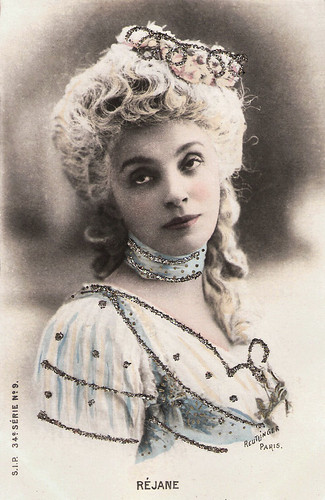
French postcard by S.I.P., 34e série, no. 9. Photo: Reutlinger, Paris.
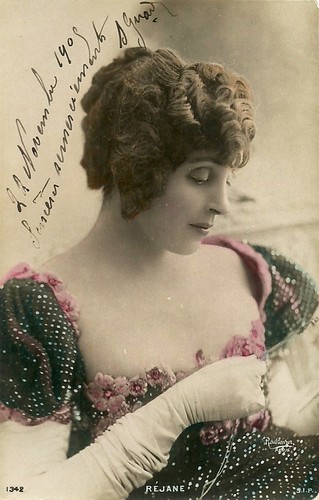
French postcard, no. 1342. Photo Reutlinger, Paris. Mailed in 1905.

French postcard by S.I.P., no. 1874. Photo: Reutlinger, Paris. Mailed in 1911.
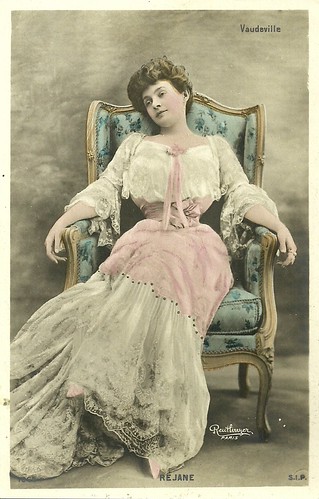
French postcard by S.I.P.. Photo Reutlinger, Paris. Caption: Vaudeville.

French postcard by A.L., no. B. 146.
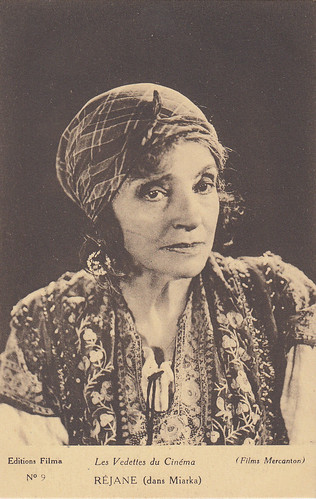
French postcard by Editions Filma in the Les vedettes du cinéma series, no. 9. Photo: Films Mercanton. Gabrielle Réjane in Miarka, la fille à l'ourse / Gypsy Passion (Louis Mercanton, 1920). Collection: Marlene Pilaete.
Gabrielle Réjane was born as Gabrielle-Charlotte Reju in 1856 in Paris. She was the daughter of an actor.
She became a pupil of Régnier at the Conservatoire and took the second prize for comedy in 1874. Her debut was the next year, during which she played several light — especially soubrette — parts.
Her first great success was in Henri Meilhac's 'Ma camarade' (1883), in which she expressed her emotional sympathy to gain great audience appeal. She soon became known as an emotional actress of rare gifts, notably in 'Décor', 'Germinie Lacerteux', 'Ma cousine', 'Amoureuse' and 'Lysistrata'.
In 1892, a pregnant Réjane married Paul Porel, the director of the Théâtre du Vaudeville, but the marriage dissolved in 1905. Their only child was a daughter, Germaine.
In 1893, she appeared in Paris, and soon thereafter in London and New York, in her most famous role as Catherine in Victorien Sardou's 'Madame Sans-Gêne'. Her performances in the play made her as well known in England and the United States as in Paris, and in later years she appeared in characteristic parts in both countries, being particularly successful in 'Zaza' and 'La Passerelle'.

French postcard by Ed. Le Deley, Paris. Photo: Nadar. Gabrielle Réjane in the stage play 'Madame Sans-Gêne' by Victorien Sardou and Émile Moreau, performed at the Paris-based Théâtre Moncey. Réjane played the outspoken laundress Catherine Hübscher, who later becomes the Duchess of Danzig. The play was written by Sardou and Moreau for Réjane and was first performed on 27th October 1893 at the Théâtre du Vaudeville in Paris, owned by her then husband, Paul Porel. So our cards are for a later version, again with Réjane - even if Gallica does not indicate any staging of the play at this theatre with Réjane in the lead. Perhaps the play was supposed to take place at the Moncey and was then moved to another theatre. Indeed, after the first performances in 1893, Réjane would repeat the play several times at her own Théâtre Réjane (opened in 1906).
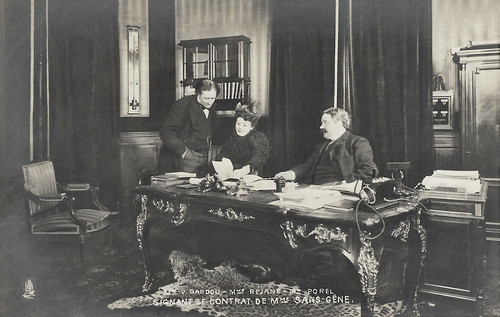
French postcard by Raphael Tuck & Fils, Editeurs, Paris, Série 200. Photo: publicity still for the stage play 'Madame Sans-Gêne'. Caption: Victorien Sardou, Madame Réjane and Léon Porel signing the contract for 'Madame Sans-Gêne'.

French postcard by E. Le Deley, Paris. Photo: Nadar. Gabrielle Réjane as Catherine, the Madame Sans-Gêne in the play 'Madame Sans-Gêne' (1893) by Victorien Sardou, performed at the Théâtre Moncey in Paris. The man next to her is Lerand, who plays Fouché.

French postcard by Ed. Le Deley, Paris. Photo: Nadar. Gabrielle Réjane in the stage play 'Madame Sans-Gêne' by Victorien Sardou and Émile Moreau, performed at the Paris-based Théâtre Moncey. The man could be Adolphe Candé, who plays Lefèbvre, the former sergeant who, meanwhile, thanks to his war feats, has become Marshall of the Empire and Duke of Dantzig.

Italian postcard by Alterocca, Terni, no. 4409. Postcard mailed in 1904. This is a still from Act 3 of the French performance of 'Madame Sans-Gêne' by Victorien Sardou, with Gabrielle Réjane as Catherine, aka the Duchess of Danzig, Georges Grand as Count Neipperg, and Edmond Duquesne as Napoleon Bonaparte. Caption: Napoleon: For this, I should have had you strangled, but out of respect for you, Sir, I won't.
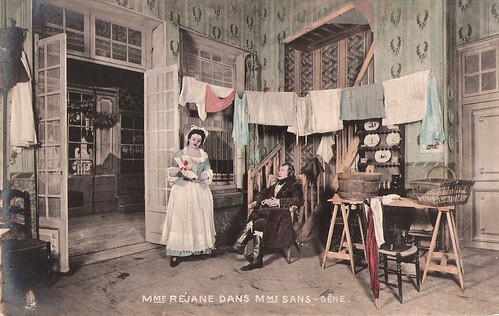
French postcard by Raphael Tuck & Fils, Editeurs, Paris, Série 200. Photo: publicity still for the stage play 'Madame Sans-Gêne'.
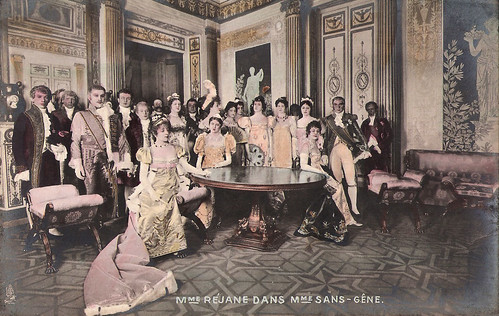
French postcard by Raphael Tuck & Fils, Editeurs, Paris, Série 200. Photo: publicity still for the stage play 'Madame Sans-Gêne'.

French postcard by Raphael Tuck & Fils, Editeurs, Paris, Série 200. Réjane in her dressing-room. The colouring and the serial number remind us of our cards for Réjane's play 'Madame Sans-Gêne' (1893).
In 1906, Gabrielle Réjane opened the Théâtre Réjane, where she continued to act as well as manage the theatre. The French vivacity and animated expression that was Réjane's trademark made her unrivalled in the parts which she had made her own.
Along with Sarah Bernhardt, she served as the model for the character of the actress Berma in Marcel Proust's novel 'In Search of Lost Time' (A la Recherche du Temps Perdu).
Réjane appeared in several short films during the early years of cinema, including an experimental 1900 sound film for the Phono-Cinéma-Théàtre, shown at the Paris 1900 World Fair. This was a short gay pantomime, including a can-can, inserted in Réjane's play 'Ma Cousine'.
In 2010, the Cinémathèque française restored the remaining elements from the Phono-Ciné-Theatre in 2k and showed it at the 2012 Giornate del Cinema Muto in Pordenone - it was a stormy success.
While IMDb and other recent online and analogue sources make many mistakes about other early film performances supposedly with Réjane, she for sure was the star of the film adaptation Madame Sans-Gêne (André Calmettes, Henri Desfontaines, 1911). It was produced by Film d'Art. According to Richard Abel, the film was so popular that it convinced Sarah Bernhardt to act in her first film, La Dame aux camélias / Camille (André Calmettes, Louis Mercanton, Henri Pouctal, 1912).
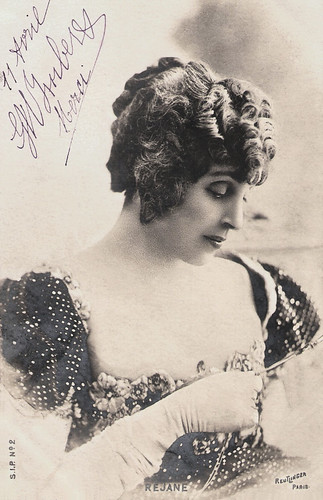
French postcard by S.I.P., no. 2. Photo: Reutlinger, Paris.
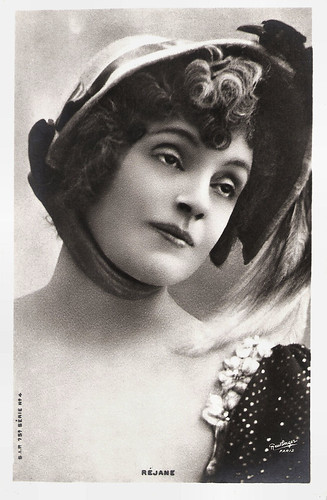
French postcard by S.I.P., 75th Series, no. 4. Photo: Reutlinger, Paris.
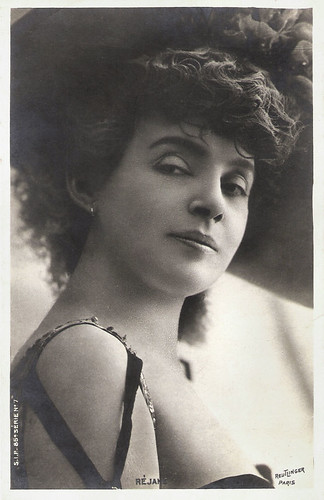
French postcard by S.I.P., 85th Series, no. 7. Photo: Reutlinger, Paris.
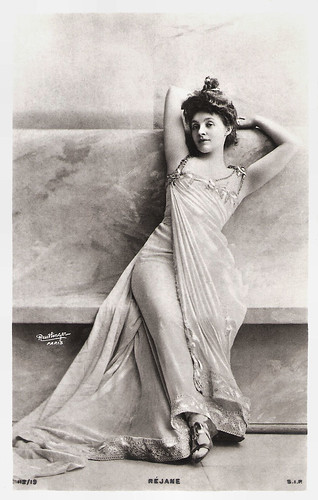
French postcard by S.I.P., no. 118/19. Photo: Reutlinger, Paris.
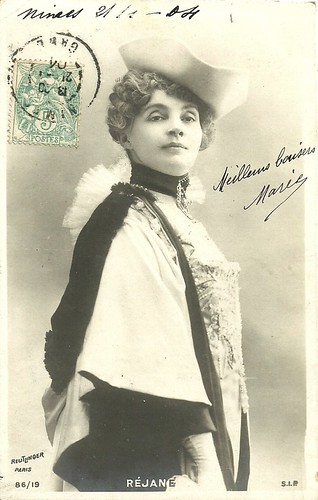
French postcard by S.I.P., no. 86/19. Photo Reutlinger, Paris. Mailed in 1904.
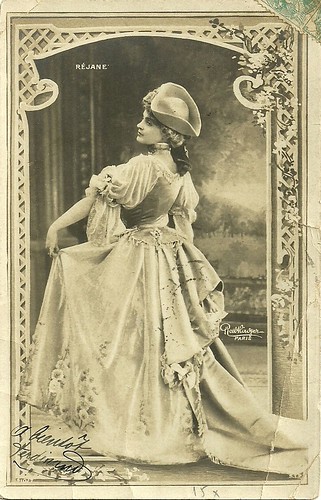
French postcard by S.I.P. Photo Reutlinger, Paris. Mailed in 1906.
Gabrielle Réjane's other films include the propaganda film Alsace (Henri Pouctal, 1916) and Miarka, la fille à l'ourse / Gypsy Passion (Louis Mercanton, 1920) starring Desdemona Mazza and Ivor Novello.
In Alsace (Henri Pouctal, 1916), a film that luckily still survives, Gabrielle Réjane reprised the role Gaston Leroux had written for her as a stage play, with which she had been very successful in early 1913 at her own theatre.
Two families, one French, one German, rival each other in the contested province of the Alsace. The French son (Albert Dieudonné) falls in love with the daughter of the Germans, Marguerite (Francesca Flory), but his mother (Réjane) tries to prevent the marriage plans. When he falls ill, she gives in. When war breaks out, he must choose between his German fiancée and his French mother. Both women are fanatics and plotters; the man, instead, is weak. He is beaten up by a German mob and dies in his mother's arms.
When the film premiered at the Paris Gaumont-Palace, it was a massive success, especially for the final image of Réjane posing as the Marseillaise on the tomb of her son. An incomplete, tinted version of the film was found and restored by the Dutch Eye Filmmuseum. A complete version will be shown at Il Giornate Muto in Pordenone in 2026.
Gabrielle Réjane was made a Knight of the Legion of Honour three months before her death. She died in Paris in 1920 and was buried there in the Cimetière de Passy.
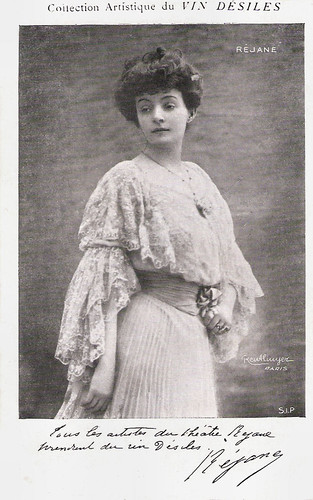
French postcard by S.I.P., for Vins Désiles. Photo: Reutlinger, Paris.
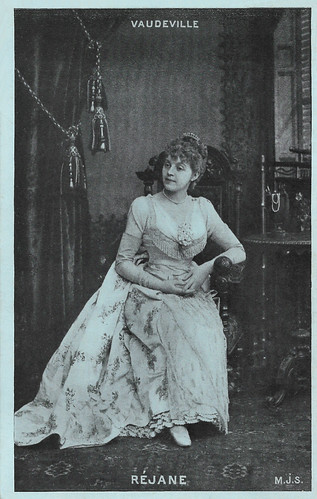
French postcard by M.J.S. Caption: Vaudeville.
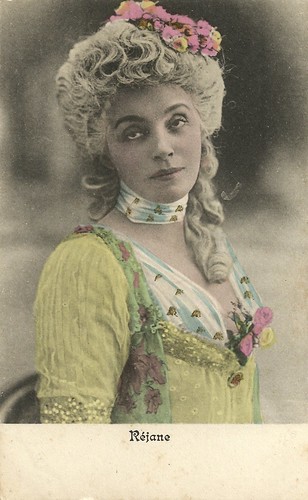
French [?] postcard, Series 129.

French postcard by A.N., Paris, no. 42. Photo: Reutlinger, Paris.

British postcard in The Wrench series, no. 4700. Printed in Saxony.

French postcard by Films Mercanton, Paris. Gabrielle Réjane and Desdemona Mazza in Miarka, la fille á l'ourse / Miarka, the Child of the Bear (Louis Mercanton, 1920). Caption: Miarka, la fille á l'ourse by Mr. Jean Richepin, of the Académie Française. Mrs Rejane in the role of la Vougne.
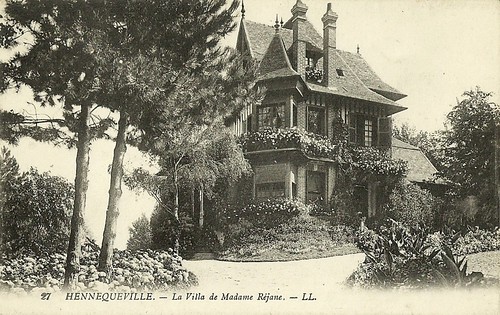
French postcard, no. 27. Caption: Hennequeville - La Villa de Madame Réjane. L.L.
Sources: Richard Abel (The Ciné Goes to Town), Kit and Morgan Benson (Find A Grave), Wikipedia and IMDb.

French postcard by S.I.P., 34e série, no. 9. Photo: Reutlinger, Paris.

French postcard, no. 1342. Photo Reutlinger, Paris. Mailed in 1905.

French postcard by S.I.P., no. 1874. Photo: Reutlinger, Paris. Mailed in 1911.

French postcard by S.I.P.. Photo Reutlinger, Paris. Caption: Vaudeville.

French postcard by A.L., no. B. 146.

French postcard by Editions Filma in the Les vedettes du cinéma series, no. 9. Photo: Films Mercanton. Gabrielle Réjane in Miarka, la fille à l'ourse / Gypsy Passion (Louis Mercanton, 1920). Collection: Marlene Pilaete.
An emotional actress of rare gifts
Gabrielle Réjane was born as Gabrielle-Charlotte Reju in 1856 in Paris. She was the daughter of an actor.
She became a pupil of Régnier at the Conservatoire and took the second prize for comedy in 1874. Her debut was the next year, during which she played several light — especially soubrette — parts.
Her first great success was in Henri Meilhac's 'Ma camarade' (1883), in which she expressed her emotional sympathy to gain great audience appeal. She soon became known as an emotional actress of rare gifts, notably in 'Décor', 'Germinie Lacerteux', 'Ma cousine', 'Amoureuse' and 'Lysistrata'.
In 1892, a pregnant Réjane married Paul Porel, the director of the Théâtre du Vaudeville, but the marriage dissolved in 1905. Their only child was a daughter, Germaine.
In 1893, she appeared in Paris, and soon thereafter in London and New York, in her most famous role as Catherine in Victorien Sardou's 'Madame Sans-Gêne'. Her performances in the play made her as well known in England and the United States as in Paris, and in later years she appeared in characteristic parts in both countries, being particularly successful in 'Zaza' and 'La Passerelle'.

French postcard by Ed. Le Deley, Paris. Photo: Nadar. Gabrielle Réjane in the stage play 'Madame Sans-Gêne' by Victorien Sardou and Émile Moreau, performed at the Paris-based Théâtre Moncey. Réjane played the outspoken laundress Catherine Hübscher, who later becomes the Duchess of Danzig. The play was written by Sardou and Moreau for Réjane and was first performed on 27th October 1893 at the Théâtre du Vaudeville in Paris, owned by her then husband, Paul Porel. So our cards are for a later version, again with Réjane - even if Gallica does not indicate any staging of the play at this theatre with Réjane in the lead. Perhaps the play was supposed to take place at the Moncey and was then moved to another theatre. Indeed, after the first performances in 1893, Réjane would repeat the play several times at her own Théâtre Réjane (opened in 1906).

French postcard by Raphael Tuck & Fils, Editeurs, Paris, Série 200. Photo: publicity still for the stage play 'Madame Sans-Gêne'. Caption: Victorien Sardou, Madame Réjane and Léon Porel signing the contract for 'Madame Sans-Gêne'.

French postcard by E. Le Deley, Paris. Photo: Nadar. Gabrielle Réjane as Catherine, the Madame Sans-Gêne in the play 'Madame Sans-Gêne' (1893) by Victorien Sardou, performed at the Théâtre Moncey in Paris. The man next to her is Lerand, who plays Fouché.

French postcard by Ed. Le Deley, Paris. Photo: Nadar. Gabrielle Réjane in the stage play 'Madame Sans-Gêne' by Victorien Sardou and Émile Moreau, performed at the Paris-based Théâtre Moncey. The man could be Adolphe Candé, who plays Lefèbvre, the former sergeant who, meanwhile, thanks to his war feats, has become Marshall of the Empire and Duke of Dantzig.

Italian postcard by Alterocca, Terni, no. 4409. Postcard mailed in 1904. This is a still from Act 3 of the French performance of 'Madame Sans-Gêne' by Victorien Sardou, with Gabrielle Réjane as Catherine, aka the Duchess of Danzig, Georges Grand as Count Neipperg, and Edmond Duquesne as Napoleon Bonaparte. Caption: Napoleon: For this, I should have had you strangled, but out of respect for you, Sir, I won't.

French postcard by Raphael Tuck & Fils, Editeurs, Paris, Série 200. Photo: publicity still for the stage play 'Madame Sans-Gêne'.

French postcard by Raphael Tuck & Fils, Editeurs, Paris, Série 200. Photo: publicity still for the stage play 'Madame Sans-Gêne'.

French postcard by Raphael Tuck & Fils, Editeurs, Paris, Série 200. Réjane in her dressing-room. The colouring and the serial number remind us of our cards for Réjane's play 'Madame Sans-Gêne' (1893).
French vivacity and animated expression
In 1906, Gabrielle Réjane opened the Théâtre Réjane, where she continued to act as well as manage the theatre. The French vivacity and animated expression that was Réjane's trademark made her unrivalled in the parts which she had made her own.
Along with Sarah Bernhardt, she served as the model for the character of the actress Berma in Marcel Proust's novel 'In Search of Lost Time' (A la Recherche du Temps Perdu).
Réjane appeared in several short films during the early years of cinema, including an experimental 1900 sound film for the Phono-Cinéma-Théàtre, shown at the Paris 1900 World Fair. This was a short gay pantomime, including a can-can, inserted in Réjane's play 'Ma Cousine'.
In 2010, the Cinémathèque française restored the remaining elements from the Phono-Ciné-Theatre in 2k and showed it at the 2012 Giornate del Cinema Muto in Pordenone - it was a stormy success.
While IMDb and other recent online and analogue sources make many mistakes about other early film performances supposedly with Réjane, she for sure was the star of the film adaptation Madame Sans-Gêne (André Calmettes, Henri Desfontaines, 1911). It was produced by Film d'Art. According to Richard Abel, the film was so popular that it convinced Sarah Bernhardt to act in her first film, La Dame aux camélias / Camille (André Calmettes, Louis Mercanton, Henri Pouctal, 1912).

French postcard by S.I.P., no. 2. Photo: Reutlinger, Paris.

French postcard by S.I.P., 75th Series, no. 4. Photo: Reutlinger, Paris.

French postcard by S.I.P., 85th Series, no. 7. Photo: Reutlinger, Paris.

French postcard by S.I.P., no. 118/19. Photo: Reutlinger, Paris.

French postcard by S.I.P., no. 86/19. Photo Reutlinger, Paris. Mailed in 1904.

French postcard by S.I.P. Photo Reutlinger, Paris. Mailed in 1906.
The Marseillaise on the tomb of her son
Gabrielle Réjane's other films include the propaganda film Alsace (Henri Pouctal, 1916) and Miarka, la fille à l'ourse / Gypsy Passion (Louis Mercanton, 1920) starring Desdemona Mazza and Ivor Novello.
In Alsace (Henri Pouctal, 1916), a film that luckily still survives, Gabrielle Réjane reprised the role Gaston Leroux had written for her as a stage play, with which she had been very successful in early 1913 at her own theatre.
Two families, one French, one German, rival each other in the contested province of the Alsace. The French son (Albert Dieudonné) falls in love with the daughter of the Germans, Marguerite (Francesca Flory), but his mother (Réjane) tries to prevent the marriage plans. When he falls ill, she gives in. When war breaks out, he must choose between his German fiancée and his French mother. Both women are fanatics and plotters; the man, instead, is weak. He is beaten up by a German mob and dies in his mother's arms.
When the film premiered at the Paris Gaumont-Palace, it was a massive success, especially for the final image of Réjane posing as the Marseillaise on the tomb of her son. An incomplete, tinted version of the film was found and restored by the Dutch Eye Filmmuseum. A complete version will be shown at Il Giornate Muto in Pordenone in 2026.
Gabrielle Réjane was made a Knight of the Legion of Honour three months before her death. She died in Paris in 1920 and was buried there in the Cimetière de Passy.

French postcard by S.I.P., for Vins Désiles. Photo: Reutlinger, Paris.

French postcard by M.J.S. Caption: Vaudeville.

French [?] postcard, Series 129.

French postcard by A.N., Paris, no. 42. Photo: Reutlinger, Paris.

British postcard in The Wrench series, no. 4700. Printed in Saxony.

French postcard by Films Mercanton, Paris. Gabrielle Réjane and Desdemona Mazza in Miarka, la fille á l'ourse / Miarka, the Child of the Bear (Louis Mercanton, 1920). Caption: Miarka, la fille á l'ourse by Mr. Jean Richepin, of the Académie Française. Mrs Rejane in the role of la Vougne.

French postcard, no. 27. Caption: Hennequeville - La Villa de Madame Réjane. L.L.
Sources: Richard Abel (The Ciné Goes to Town), Kit and Morgan Benson (Find A Grave), Wikipedia and IMDb.
No comments:
Post a Comment